This is the second lesson in the series devoted to walking bass lines. This lesson is the first look into how we construct the actual lines and starts with a primer on Arpeggios or Chord Tones. Chord Tones should be the first stop on the road to learning how to play walking bass lines.
When we see a chord progression and need to create a walking bass line, the chords are provided so they are the first clue as to what melodic building blocks are available. Scales can be deduced from the progression by knowing a little functional harmony but chords are right there on the chart so it’s imperative that we learn them.
This lesson covers the three most popular chords: Major 7, Dominant 7 and Minor 7. Each chord is shown in basic arpeggio form before moving into more useful fingering patterns that cover every chord tone in each possible position. This is very useful in weaving a walking bass line through a chord progression while holding one position.
This is a long lesson so here’s an index for anyone needing to move to certain areas:
02:00 – Root Note Targeting
06:50 – Major 7, Minor 7 and Dominant 7 Arpeggios
10:09 – Arpeggios through the chord progression
12:34 – The Three Fingering Patterns for each Arpeggio (1st, 2nd, 4th finger)
16:47 – New fingerings through the progression
19:56 – Extending the patterns within a position
34:25 – Constructing the line
Root Note Targeting
To start this lesson, we first need a chord progression. We will use the same one from the last lesson – a I vi ii V in C major.
CMaj7 | Am7 | Dm7 | G7
Before we create a line, we need to be aware of the basic chord root notes. It may seem simple and easy at first, but playing the progression sticking to the roots will help you later on when we get round to targeting.
We will stay in the first position for now so we don’t have to move around.

Some of our root notes appear more than once in the first position:

Remember to transpose things you learn into other keys. Not only will you improve your fretboard knowledge, but it will force you to learn every exercise more thoroughly. Here is the same progression in F:

Building Chords
We have covered building chords in more detail in other lessons, but here is a quick recap:
- Chords are built by stacking thirds
- A basic triad is built from the root, 3rd and 5th of a scale
- Triads can be extended by adding the 7th, 9th, 11th and 13th
Here is the construction of a few popular chords you will come across frequently:
Major – 1 3 5 – C E G
Minor – 1 b3 5 – C Eb G
Diminished – 1 b3 b5 – C Eb Gb
Major 7 – 1 3 5 7 – C E G B
Minor 7 – 1 b3 5 b7 – C Eb G Bb
Dominant 7 – 1 3 5 b7 – C E G Bb
Minor 7b5 – 1 b3 b5 b7 – C Eb Gb Bb
Familiarise yourself with these spellings before you move on.

Now let’s add the relevant arpeggios to our chord sequence:


Arpeggio Fingering Patterns
The next step in learning arpeggios is to nail the three fingering patterns for each one. Any arpeggio or scale can be played starting from one of three fingers in a kind of ‘upper‘, ‘middle‘ and ‘lower‘ position.
Here are the three fingering patterns for each chord we will be using:



Now we can rearrange our fingering for the original progression so we don’t have to change positions.

Again, don’t forget to transpose it:

Extended Patterns Within A Position
Below are the arpeggios again but each one contains all the notes available in one position.








Constructing A Walking Bass Line
Now we have our chord tones in place, we can move on to creating a walking line through our I vi ii V progression. We already have our root notes to act as waypoints, so we just need three extra notes in each bar to move from one to another.
When creating your line, remember to lead in to the next chord using a tone that is close to your target note to avoid sounding ‘blocky’. Here are some examples of walking bass lines that work through the progression – study these and when you’re ready, come up with your own.
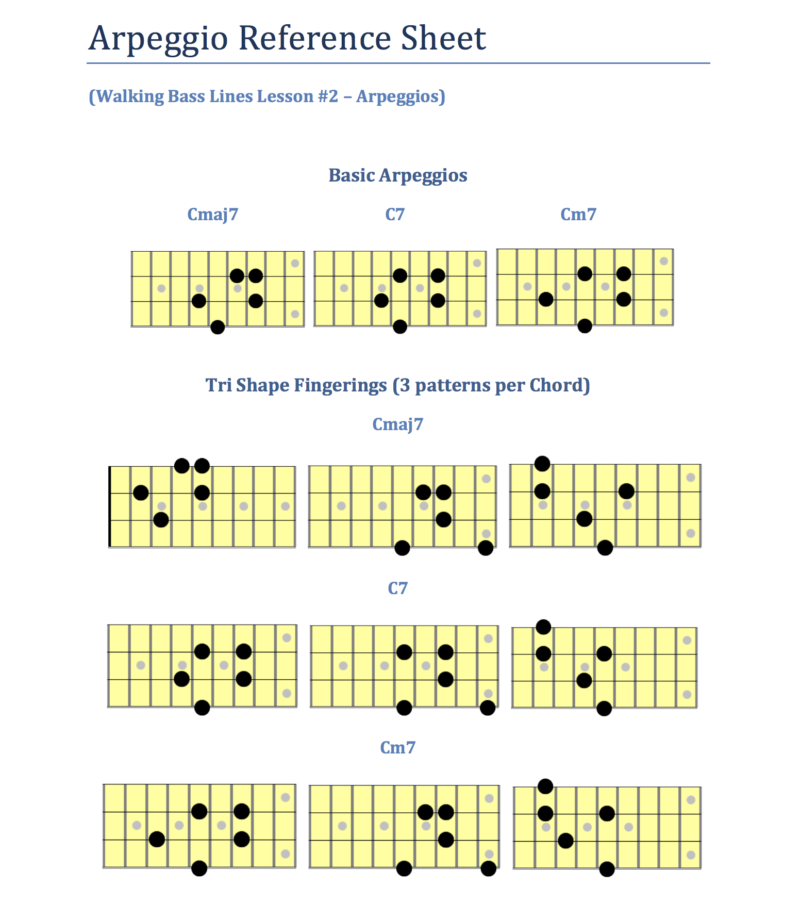
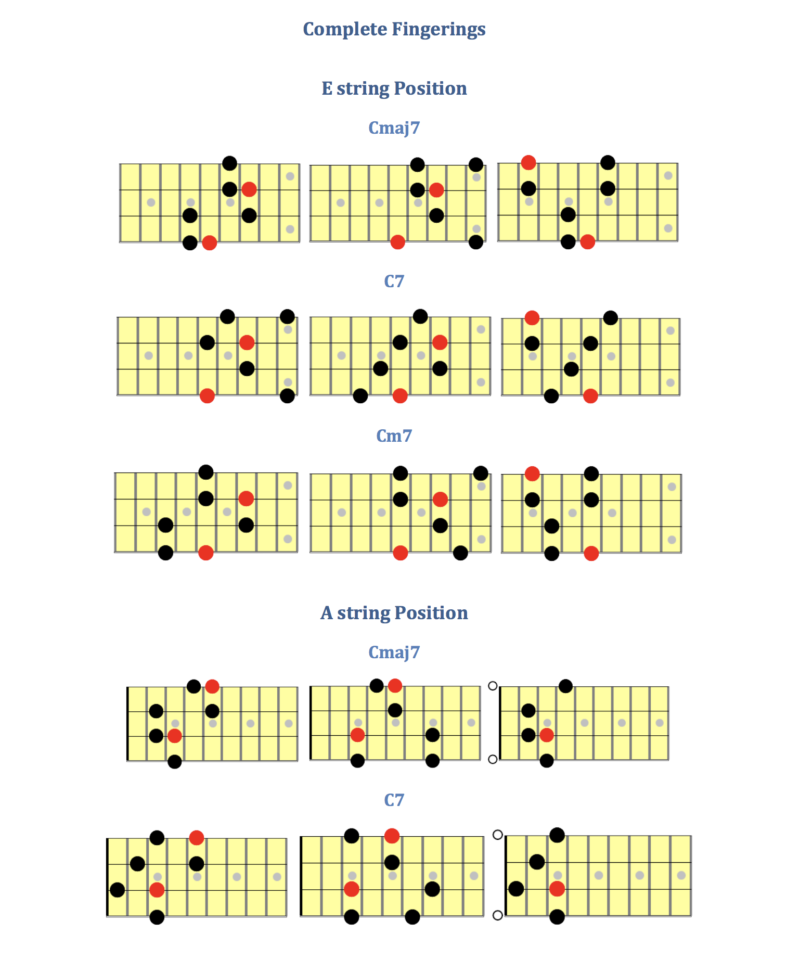
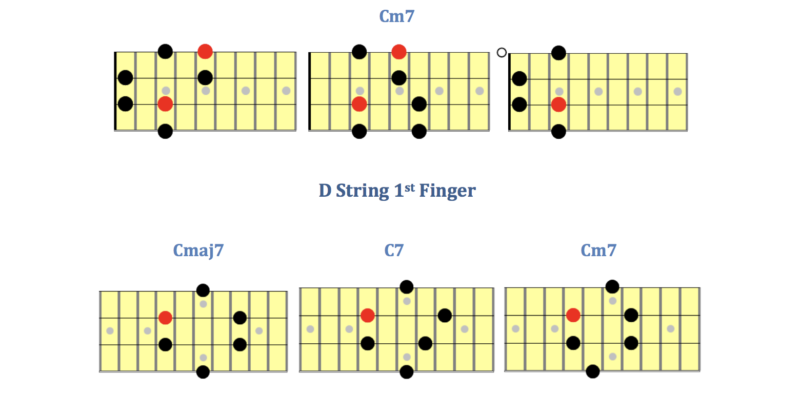


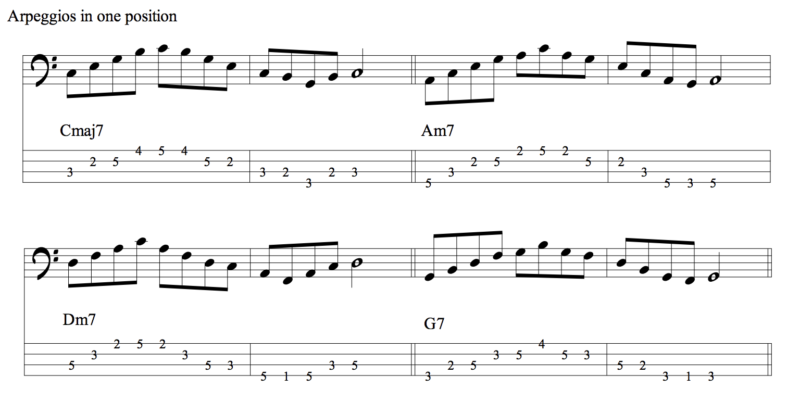




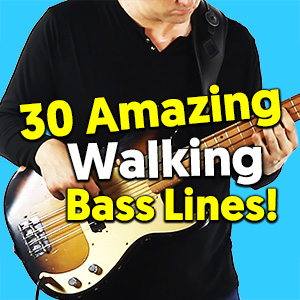
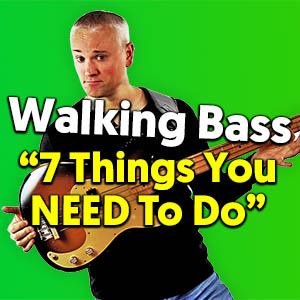
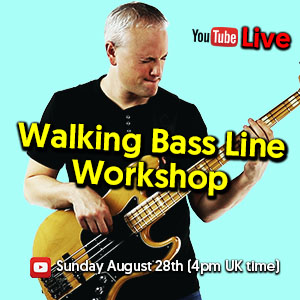
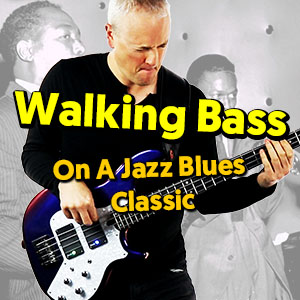
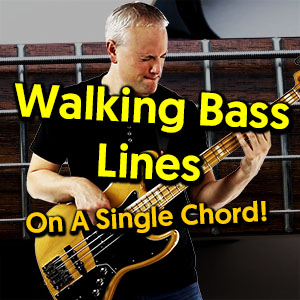
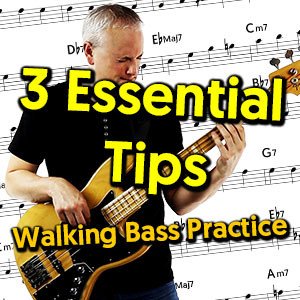


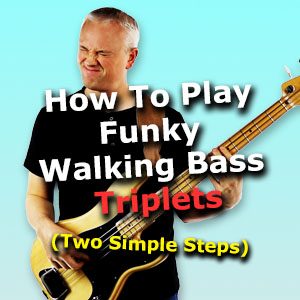

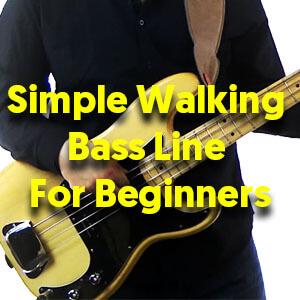
Awesome lesson and walking bass line series you have going on. I believe it might finally start to “click” for me. Appreciate your help. It might just be me, but I did not see a PDF to go with this lesson. thanks again, jay
Coming soon.
Mark—just downloaded the info for this lesson. Much thanks. Greetings from Texas.
Its been approx 3-4 months that i follow the lessons and its really surprising to see progress with my playing on the bass and my music teory knowledge is getting better and better. Thank you for your hard work.
And I really recommend Mark’s study book of bass guitar. It is big help to hand positions and building walking bass lines.
Thanks very much. Good that people are digging the Study Book Of Scales.
thanks for the lesson mark.
your lesson help me a lot to learn bass note
for me as new one in this thing it help me.
thanks .
I like the way you are teaching, keep up the good work. I have a question after watch this video, I can’t find the download site for the backing track, please advise to where it is at. I have signed up for other bass web sites, but none is as good as yours. William Rees
Thanks a lot William. The download will be coming up shortly.
Thank you Mark, as always, great lesson!
I believe the first fingering (middle position)) in the “Tri Shape Fingerings (3 patterns per Chord)” section in the Arpeggio Reference Sheet
is wrong. It should start on the E string, currently is starts on the A string..
This is excellent and I truly appreciate it! Maybe you already have this in another lesson, but are you going to cover ideas for walking over a blues, where we have multiple measures of each chord?
This the kind of information I need to see where I am at with my bass playing, You are a good teacher and I wish I had discovered you sight sooner, If you ever find the time to make available you lessons on Pay pal Credit, that not paypal, they messed up my checking account a couple of years ago and I got rid of all my credit cards and if I need anything I find it on Ebay and pay for it with paypal credit. This way the seller gets his money then and I have a month to pay them it has worked out well for me and other sellers and buyers. Thanks again for this information. Bill
Gracias, lo encontré por casualidad en you tube, y ya me suscribí, las lecciones me parecen buenas y el método excelente, podrías hacer la traducción al spanish. te lo agradeceríamos . Te seguire!!! y a tus lecciones.
The Apreggio Reference Sheet has another mistake besides the A-string and E-string mismatch as mentioned by Shay. The 2nd tri shape fingering position for Cm7 is incorrect, it shows the Cmaj7 fingering position. Thanks again for the excellent lessons Mark.
Thanks Mark you are easy to follow I am still at basic stages and do have difficulty with the little finger which will probably get better with practice do you thin that the apreggio scales will improve this, or should I try some other method.
First time it was made clear to me that it’s important to learn the finger positions. No wonder I was so clunky before.
This was very useful. Thank you. Now I know what I want to practice (chord arpeggios for now)
I however extended the Arpeggio reference sheet to add a 5th string (quick and dirty) :)
https://drive.google.com/file/d/1yLJyNHCJq2L5-wWBoF37bVQgr58eHx_q/view?usp=sharing
Blue: fits in the scale; Grey: “out of bounds”
thankyou for a brilliant easy to follow lesson
Nice lesson, i have some question in my mind. what if the chord progression has no 7th just Cmaj – Am – Dm – G. how do i replace those 7th notes ?
Sorry, where can iI download de the PDF of this lesson? thanks!
Cant find the pdf
Great Stuff!!!! I think that there is an error in the Cm7 box, the dot should be on the flat 7
I’m a lifelong guitarist (age 59), that was just asked to play bass in a horn-band…I don’t even own a bass, yet. This lesson has really turned the “light bulb” on. It is such a blast to learn this material on bass! I feel like a kid again trying to practice all this and get it down. Thanks, for all of your hard work and willingness to teach!
Mark from talkingbass.net, what can I say? You’re amongst my top10 bassist teachers online that are available in the whole internet. Thank you so much for this lesson! That was the thing I needed for studying and practicing Jazz Walking Bass lines in Jazz together with the #1 Walking Bass Lesson, Walking Bass playing tips, tricks and hacks few lessons, few lessons with Walking Jazz Bass Lines, Jazz Standards and Progressions Bass Lessons and my favourites using Billie’s Bounce these 4 lessons with Chord Comping Pattern, Walking Bass Line, Another Bass Line and the 4th one using playing around Chords with quarter notes (I don’t even have to tell you because you obviously exactly know which 4 lessons using Billie’s Boune as an example are but I just treat them as my personal favourites and lessons which let me dig deeper into Jazz style which is one of my favourite music genres alongside with Black Metal, Brutal Death Metal, Rap, Trap, Prog Rock, Doom Metal, Viking Metal, Folk Metal, Drum and Bass, Deep Dubstep, Swing, Trad Jazz, Bluegrass, Country, Soul, Nwo-Soul, old bass-powered Funk and RnB and Motown sound). Thank you for these Walking Bass lessons and exactly this long lesson. It helped me to really get into Walking Bass in Jazz which I love as a music genre like I mentioned above (especially Miles Davis, John Coltrane, Charles Mingus, Art Blakey and The Jazz Messengers, Dexter Gordon, Sonny Rollins, Ornette Coleman, Bill Evans, Dave Brubeck, Thelonious Monk and many others but these musician are my top 11) and your lessons ans this lesson helped me to develop chord underdstanding in Jazz, getting through Chord Progessions, some Jazz Standards, Walking Bass and role of bass in jazz. I really love your lessons and I think you are one of the best teachers in the world and keep it going, Mark. You’re great teacher, great bassist, great musician, great friendly person and you’re cool and I like you and appreciate you. I would like to talk with you in reality or on Skype if there would be a possibility and if it is let me know on my e-mail: braveviking97@gmail.com, my polish phone number +48 668 786 908, my Instagram: braveviking97, my Snapchat: braveviking97 and facebook and messenger is Michał Waroński – my polish name and surename but call me Mike! :) I use also JamPlay.com and I pay a lot and I play 8 hours a day using their website (I play 10h/day so 2 hours left and I spend those two hours almost only on talkingbass.net 80% of time!!!!) As I said I love your website, the content, lessons, the fact that it’s for free, the diversity of material, the way you record those videos and texts and notation/tabs underneaths the video and I like your taste in music and personality as much as I know you so as for now – my bass teacher, one of the bests, I also like few teachers on JamPlay (this website has thousands of lessons, it’s well organised and has great content divided into musc genres, theory, techniues, speed and stamina, fingering/picking with a plectrum exercises, reading notation, learning songs, informational videos with no supplementals and many many more and the way they are teaching and the materials and the way they are teaching and explaining is great, many teachers are like your friends, just like you and you can download notation with tabs for every lesson and backing tracks for all lessons with playing over a song or a backing track in versions full mix, full mix no bass, drums only and if you pay more you can also download videos. I store everything in a special file and I have everything I have already done and I can always come back on my websie and after 1,5 years of doing every lesson on JamPlay twice I will stil have materials and I will be able to remind myself what I need, practice, do some exercises and teach students and MAYBE SHARE STUFF WITH OTHER TEACHERS and other students !!! :D :P :) ;) \m/) and if it comes to teachers I also like Dan Hawking from onlinebasscourses.com or onliebasslessons.com, I can’t remember now but prolly the first one. So YOU, JamPlay and Dan Hawking. And I will keep it like this. It’s super cool that your provide 4 useful free PDFs and I texted probably YOU (?) on a private messaege”to talkingbass” and I commented under your PDFs because I gave you an idea that if you have time you can create some new PDFs: one with approach to different genres f.e. heavy metal like (NWOBHM), black metal, death metal, doom metal, metalcore, deathcore, classic rock, prog rock, indie rock, pop-rock, fusion, blues, funk, funk rock, Motown, soul, neo-soul, pop, punk, punk rock, punk metal like new Darkthrone, Modal Jazz, Free Jazz, Bebop, Hard Bop, Cool Jazz, Funky Jazz and other genres if you like, second PDF (THE MOST IMPORTANT IN MY OPINION) “Building Walking Bass Line for Jazz Beginners with Building Jazz Walking Bass from Root Notes, adding 3rds and 5ths, adding 7ths, adding octaves, adding passing notes (diatonic and chromatic), explaining how to find 2nds, 3rds, 4ths, 5ths, 6ths and 7ths below, 5th is easy because it’s just the same fret on a lower string but the rest (??? f**k no… how to find it?!), then more advanced stuff in walking bass lines, improvising with walking jazz bass lines, creating your own walking bass lines from very beginning so you start a PDF by playing Root Notes and finish it knowing how everything works and being able to play some example walking bass lines (now if you would throw there some examples of walking bass lines just to learn, practice and play track to feel the jazz drummer and to play some walking bass to your family and friends and just to yourself) and finishing the PDF also with knowledge where all these possible walking bass line notes come from and how to write your own walking bass lines and you could also throw some notation and tabs for cool walking bass lines from famous jazz upright bassists like Charles Mingus and his album “Ah Um” and other cool bassists and lines and whatever cool walking bass lines you know and also bass chords comping for it someone would like to learn jazz chords and just standard chords you always play on higher notes (lower on neck than 12th fret) and there are many types of chords so it would be useful soo much! And 3rd PDF could be devoted to f.e. examples of cool basslines, riffs, grooves and examples of nice rock, metal, funk, slap, motown, soul, punk etc. and how to create your own basslines, riffs and grooves and also licks, throw in some cool licks, also jazz licks and than how to create licks using scales, modes, passing tones, chromatics or diatonic notes, arpeggios, triads etc. and it would be cool. If you have tine please think about it. You didt’t reply to my comment or to my message so I thought I will write this ideas here while commenting this awesome lesson that you did on walking bass lines. I love it as I love your other lessons! <3 It's only a pity that you don't have just ONE or TWO lessons about black metal and it's best subgenres such as atmospheric black metal like Drudkh, The Ruins of Beverast, Summoning, depressive black metallike our beloved Xasthur and Shining, trash/black metal like Absu, especially their album Tara (Absu – Tara Full Album), great mix of genres with audible bass especially in Lanlos which is atmospheric black metal mixed with prog rock mixed with shoegaze mixed with blackgaze and mixed with ambient and there are top 3 bands playing this genre: Deafheaven (their albums "New Bermuda" and "Sunbather" are on of the best in whole world's music albums), Alcest (albums "Kodama" and "Escailles de Lune") and third rocking band Lantlos ( album ".neon"is their best and has nice audible bass). All of them have suprisingly audible bass and cool bassline but Lantlos on .neon has it soo much audible and well mixed and cool as f**k!! Deafheaven's New Bermuda has extremely beautiful bass also. Please try these 9 bands I mentioned, no one is traditional satanic extreme black metal, these are other subgenres and I just know you will fall in love with them if you don't know these bands yet! If not in each one of them I am 100% sure you will like this mix of genres and like these albums by Deafheaven, Alcest and Lantlos. I just know it. Think about making lessons with diffrent black metal sanks for everything! I must finish this 1h15min comment. But I will still keep up with your lessonubgenres and BM is not easy on bass, guitar and drums and it uses some theory and technique stuff and the hardest part is speed while drums are playing double bass or fast blast beats ans guitar is plying tremolo picking but it's very atmospheric and sound cool. And think about these PDF ideas if you have time. Thanks once more for everything. I must finish this 1h15min comment. I will still keep it up going with your lessons, not only Jamplay and I will wait for you answer on my comments and my text message. Love you my fav teacher! Enjoy listening to these bands and to Deafheaven's, Alcest's and Lantlos's albums. Maybe you will even change your direction and point of view! I am going to do one more lesson and go to sleep for 2.5h because it's 8:30am and I am still up because of Walking the Bass with you, Mark!!!!! Love you. Take care my best bassist and teacher. See ya later! ~ as you always say haha LD Yoooooo!